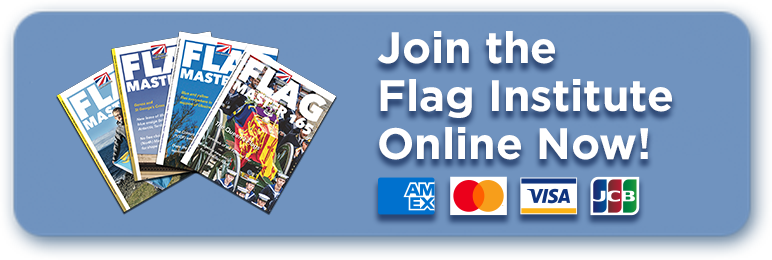SAVE THE DATE: FI AGM and Winter ’26 Conference, Saturday 14 November, 10.00 to 17.00 GMT, FREE and ONLINE
Each year we hold a Spring and a Winter Conference, and in 2021/22 we ran a special Golden Jubilee gala programme.
FI Spring ’26 Conference sponsored by Flagmakers
Saturday and Sunday, 30/31 May, Bristol
Saturday 30 May, Gather Round, 15-16 Brunswick Square, Bristol BS2 8NX
10.30am: registration opens
11am – 6pm: presentations
- Cry God for Harry, England and St … who?: An exploration of the chequered history and strange resurrection of the English national flag – John Cartledge, Flag Institute; speaker at ICV25 Rotterdam; ICV26 Sydney; ICV27 London; ICV28 San Antonio; ICV30 Beijing
Special preview of presentation to be delivered at the 31st International Congress of Vexillology in Paris, 6-10 July 2026
The summer of 2025 saw an unprecedented eruption of flags on lampposts in many English towns and cities, with the cross of St George prominent among them. But who exactly was St George, what does he have to do with England, and what message were the organisers of this sudden outburst of vexillological devotion to him seeking to convey?
- Always the bridesmaid … rank flags of vice, deputy or assistant presidents, ministers and officials – John Hall FF FFI, Flag Institute Chairman
For every Donald Trump there is often a JD Vance waiting just one step from power. Many countries have flags and standards for all manner of office-holders and their deputies. John will journey into the obscure recesses of the broom cupboard of state to explore symbols of rank, particularly those in the second or third tiers of protocol. And he will seek to answer that age-old question, ‘Why does an admiral have no balls at all?’
- Flag flying regulations and protocol – Geoff Parsons MSc CEng FIET FFI, Flag Institute Chairman (former)
Demystifying UK flag regulations and protocol, this session aims to encourage confident and informed flag flying, supported by official Flag Institute guidance. Geoff will cover where and how flags may be flown, who is permitted to fly them, and the correct procedures for display, including order of precedence and position. It will highlight real-world examples of political sensitivities, conflicts with local authorities and breaches of flag protocol, inviting delegates to review sample displays and spot instances of non-compliance.
- Subjective views on US state flags: 123 polling studies – Alan Hardy, Flag Institute; North American Vexillological Association Flag Design Committee
Furthering his interest in US state flags, in 2017 Alan established, within a public forum, a comprehensive methodology for soliciting viewpoints and administering polls on all current flags and known redesigns. From then until 2025, month-in/month-out, some 200,000 flags were assessed, and the resulting study has identified and advanced several front-running options for a vastly improved set of designs. This wrap-up presentation looks to assess the project and tries to point ways forward. How can changes be implemented without incurring vast expense or running the risk of built-in social blowback?
More speakers and presentations to be announced.
6pm – 7.30pm: Old Town walking tour
A bespoke walking tour through Bristol’s old town with experienced local guide Duncan McKellar. Duncan is the founder of the city’s top three walking tours and will lead us through historic backstreets to finish on the harbourside. Along the way we’ll touch on Bristol’s civic life, processions, public symbolism and maritime heritage, with chance to spot where coats of arms, guild histories and other emblems still shape the cityscape. We’ll discuss Bristol’s Saxon origins, its trading past, the Blitz and even 1960s rock and roll. Passing pirate haunts, merchant houses and Robinson Crusoe’s first port of call, we’ll end our unique stroll on the waterfront – at the pub where Robert Louis Stevenson wrote his classic Treasure Island.
7.30pm: President’s Drinks at the Llandoger Trow
Sunday 31 May
10.00am – 10.40am: M Shed (part of Bristol Museums)
An expert guide will bring M Shed to life, introducing its galleries, explaining how M Shed came into being, and sharing memorable stories you won’t find on any label. The tour offers a lively introduction to Bristol’s past and present, giving a vivid sense of the city’s character and its place in the wider world. Whether you already know the city or are discovering it for the first time, the tour will add colour, context and plenty of talking points to the conference weekend.
11.30am – 1pm: SS Great Britain
An expert guide will lead a lively tour of Isambard Kingdom Brunel’s legendary steamship SS Great Britain, revealing its remarkable story and the experiences of the passengers and crew who travelled the world on board. The tour explores daily life at sea, global routes and cargoes, and the ship’s role in transforming maritime travel. Along the way, our guide will highlight the use of flags and ensigns, adding an extra layer of interest for vexillologists. This visit promises an atmospheric journey through Victorian seafaring, engineering innovation, and the wider world that the SS Great Britain helped to connect.
Past events
AGM and Winter ’25 Conference
Saturday 15 November, 10.00 to 17.00 GMT, FREE and ONLINE

